Abstract
The disruption of the education system caused by the sudden outbreak of the COVID-19 pandemic has altered teaching processes forever, thus transforming the existing teaching/learning contexts and their relevance. Given that instructors are key bearers of the educational process, the perception of their teaching experience during the pandemic is vital to understanding the challenges that emerged throughout the process. This paper reports on the experiences of English as a foreign language (EFL) higher education lecturer (n=89) of their emergency remote English language teaching (ERELT) during the COVID-19 pandemic. The objective of the research was to investigate how EFL lecturers assess their own instruction and relationship with students within their ERELT, and how much their teaching in ERELT differed from regular teaching conditions. Under the computer-mediated communication theory framework, the study has adopted a mix-methods research design and the data were collected through a questionnaire. The results imply that the use of computer-assisted language learning (CALL) significantly surged in the ERELT as compared to regular teaching conditions. The teaching process was assessed as a dynamic, resourceful, and stressful process, which, judging by the communicational goals, appeared to be less interactive than more traditional face-to-face instruction, causing the relationship between students and instructors to worsen to a certain extent.
License
This is an open access article distributed under the Creative Commons Attribution License which permits unrestricted use, distribution, and reproduction in any medium, provided the original work is properly cited.
Article Type: Research Article
EUR J INTERACT MULTIMED ED, Volume 3, Issue 2, July 2022, Article No: e02211
https://doi.org/10.30935/ejimed/12272
Publication date: 26 Jul 2022
Article Views: 2996
Article Downloads: 1380
Open Access References How to cite this article
 Full Text (PDF)
Full Text (PDF)